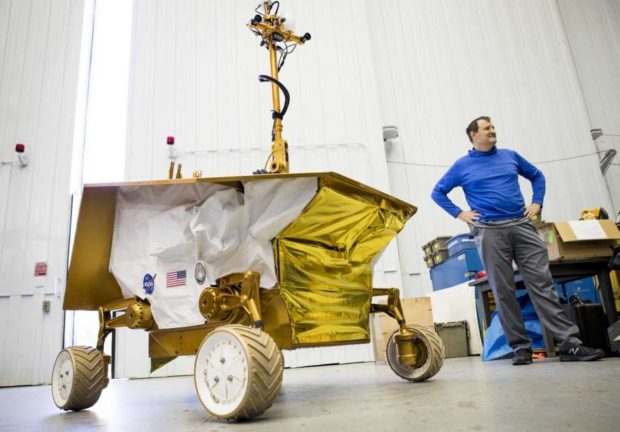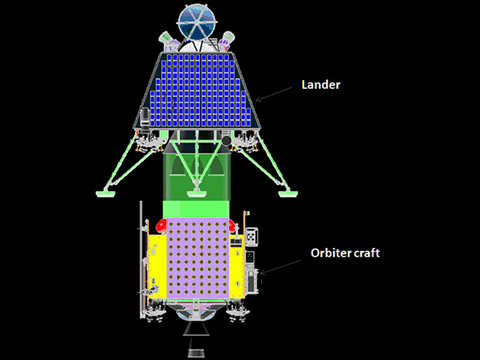In a move that shocked lunar scientists, Nasa has cancelled the only robotic vehicle under development to explore the surface of the Moon, despite President Donald Trump’s vow to Continue reading


In a move that shocked lunar scientists, Nasa has cancelled the only robotic vehicle under development to explore the surface of the Moon, despite President Donald Trump’s vow to Continue reading

The Union Minister of State (Independent Charge) of the Ministry of Development of North Eastern Region (DoNER), MoS PMO, Personnel, Public Grievances & Pensions, Atomic Energy and Space, Dr Jitendra Singh has said

In something that can be reffered to as bad news, India’s mission to launch its eighth navigation satellite where the private sector was involved for the first time in the assembly of its spacecraft failed today after a technical snag after a perfect lift off of its polar rocket. Calling the failed mission as a ‘mishap‘, ISRO Chairman Kiran Kumar said the heat shield or the aerodynamic fairing did not separate for the IRNSS-1H, a backup navigation satellite, to be put into orbit in the final leg of the launch sequence. As a result, the satellite got stuck in the fourth stage of the Polar Satellite Launch Vehicle–PSLV-C39.
“Today the launch mission has not succeeded. While all the systems of the launch vehicle performed extremely well, we had a mishap. Heat shield has not separated,”
ISRO
The eighth satellite was supposed to be a back-up navigation satellite for IRNSS-1A, one of the seven satellites in the constellation, as its three rubidium atomic clocks on board had stopped functioning. For the first time, the private sector has been actively involved in assembling and testing of a satellite unlike earlier where its role was limited to supplying components . it’s Haunting for ISRO since most of its first Launches have failed except the GSLV launch.
Today’s setback is a rare failure in India’s space mission involving the PSLV, dubbed as ISRO’s workhorse, which has had a time-tested record of 39 consecutive successful launches, ever since its maiden flight failed 24 years ago. On September 20, 1993, the first development flight PSLV-D1 was unsuccessful in launching the IRS-1E remote sensing satellite into orbit. Today’s PSLV launch was the third this year with everything appearing normal from the lift-off at 7 pm till the rocket reached the fourth stage where it is supposed to inject the satellite into orbit. However, the expected sequence did not happen and the Mission Director and other senior ISRO scientists were seen in a not so good mood, indicating all was not well. After the Mission Director declared that the heat shield had not separated, Kiran Kumar officially announced that the mission was unsuccessful.
“We are looking into the details of what has happened and we will do the analysis and subsequently come back with the details,” Kumar later told reporters. At this point of time, the basic thing was everything — the launch vehicle, first stage, second stage, third stage, fourth stage, separation part and all the events performed normally, he said.
“Because the heat shield is not separated, the satellite remainins inside the fourth stage and even satellite separation also we could see from the camera images that the satellite is moving inside the enclosure. So this mission has been an unsuccessful mission,” Kumar said.
Earlier, at the end of the 29-hour countdown that began yesterday, the 44-metre tall PSLV-C39 lifted off majestically at the scheduled time of 7 pm from the second launch pad of the Satish Dhawan Space Centre at this spaceport, about 100 km from Chennai.
The Indian Regional Navigation Satellite System (IRNSS) is an independent regional navigation satellite system developed by India on par with US-based GPS. Russia has ‘Glonass’ while ‘Galileo’ is by Europe. These satellites offer services like terrestrial and marine navigation, disaster management, vehicle tracking and fleet management, navigation aide for hikers and travellers, visual and voice navigation for drivers. This constellation was earlier named ‘NavIC’ (Navigation with Indian Constellation) by Prime Minister Narendra Modi. The NavIC system has many uses including for fishermen venturing into sea, guiding merchant ships to navigate, tracking of railway movement and alerting road users near unmanned level crossing
So do you like to read such articles , consider liking our page on Facebook here , following us on Twitter here ,or if you love some visual treatment , we make some high quality videos on YouTube as well which you can view here . have a great day :). Visit our hompage HERE for the LATEST SCIENCE NEWS.

Lone Indian Moon landing contestant TeamIndus and its four global competitors on Wednesday got a three-month extension from contest organisers to complete their space feat.

A partial eclipse of the Moon (lunar eclipse) will occur on August 7 night and it will be visible from all places of India. The eclipse will begin from 10:52 pm and will continue up to 12:49 am on August 8. Continue reading